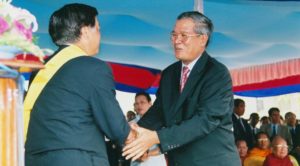IDJ-REPORT
Time for Japan to rebuild its relations with Sri Lanka
China’s shadow over Colombo LRT project cancellation
The Sri Lanka government’s policy of canceling a railway project supported by Japan last year caused a stir. Sri Lanka is gaining geopolitical weight as a key country in the Indian Ocean, and Japan is looking to resume the railway project through inter-government talks. In the background, however, Sri Lanka’s debt problems and the presence of China, the biggest donor to Sri Lanka, are casting a pall.
President points out “cost-effectiveness”
The project is to develop a 15.7km long next-generation type of tram(LRT) that would run through the biggest commercial city of Colombo. The total project cost is approximately USD 1.5 billion (JPY160 billion) and is scheduled for completion in 2026. It is the largest Official Development Assistance (ODA) ever provided by Japan to Sri Lanka. Sri Lanka grew rapidly into a middle-income country after the end of the civil war in 2009. But traffic congestion in Colombo has become more serious. The development of a mass transit system is an outstanding issue for combating air pollution and reducing greenhouse gas emissions.
In March, 2019, the Japan International Cooperation Agency (JICA) signed a loan agreement with the government led by Then-President Maithripala Sirisena for the first phase of the project, which amounted to approximately 30 billion yen. However, the presidential election in November, 2019 saw a change of government, with Former Undersecretary of Defense Gotabaya Rajapaksa as president and his brother Mahinda Rajapaksa as prime minister.
Mr. Gotabaya came to Japan in 2014, when he concurrently served as undersecretary of urban development under his brother’s administration (2005-2015), and visited monorails in Tokyo and Okinawa under JICA’s guidance.
Mahinda, meanwhile, is a strong pro-China politician that built Chinese-funded port and airport in his hometown Hambantota during the time of his presidency. In 2020, Sri Lanka also suffered with the spread of the COVID-19 virus, and the planned contract for the main body construction of the LRT was delayed. Then, in late September, Rajapaksa’s administration abruptly approved a cancellation policy.
According to local reports, President Gotabaya pointed out that “the cost-effectiveness of the project is not good.”. The former central bank governor, Minister of Finance, Capital Markets and State-Owned Enterprise Reform, said: “The priority of the current government is different from the previous one. We need to proceed not only with Colombo-centric operations, but also with projects to rescue low-income people in rural areas.”
Even more worrisome is the remarks made by Rambukwella, a cabinet spokesman and Minister of Media and Information, “We’re thinking of an efficient project that can achieve the same result within a $500 million cost.” This seems to refer to public-private partnership projects that make use of private funds. Moreover, there is a rumor that the other partnership might be a Chinese company.
After a change of government between political rivals, total cancellation of the previous administration’s policy also occurred in the United States. However, canceling an international cooperation project properly contracted between governments without prior consultation, is an act that affects international trust.
When Sirisena’s administration took over from Mahinda Rajapaksa in 2015, it revised the foreign policy of the previous administration, which was too biased toward China, and shifted to a multilateral, balanced diplomacy, including Japan and India. The Chinese-backed “Port City Plan” in Colombo was also suspended and reconsidered. As the number of development assistance has become more diversified, the LRT project has been realized.
However, the LRT business seems to have been running aground in rough seas of governmental change once again. Japan is in talks between the governments, calling for the cancellation to be withdrawn and the project to resume. However, Sri Lanka’s debt problem is also related, and the future of the talks is difficult to predict.
China expands presence during the COVID-19 Crisis
In early October, 2020, about two weeks after the announcement of the cancellation, a Chinese government official arrived in Colombo. Yang Jiechi, a former Foreign Minister and a member of the Central Political Bureau of the Communist Party of China (CP).
According to an announcement by the Ministry of Foreign Affairs of China and the China International Development Cooperation Agency (CIDCA), the two countries agreed to cooperate in human resource development, such as the opening of a technical university in Hambantota, and to further promote the Belt and Road Initiative. In addition, according to local media reports, financial assistance to the debt-ridden Sri Lankan government seems to have become a focus. October, 2020, was a time when China’s developments in the debt problems of the world’s developing countries were closely watched ahead of the G20 Finance Ministers and Central Bank Governors’ Meeting and the annual meetings of the International Monetary Fund (IMF) and the World Bank.
According to the IMF, Sri Lanka’s foreign debt balance (2019) is about $56 billion. It accounts for 69% of the country’s GNI. Debt risks have increased, as the economy has been hit hard by the COVID-19 crisis and the country’s bond rating has also been lowered. In March, 2020, China provided a lower-interest loan of $500 million to help Sri Lanka combat the virus, but Sri Lanka has asked for additional assistance.
In October, China agreed to provide $90 million in grant aid to CIDCA for technical cooperation in rural Sri Lanka, including healthcare, education and water supply. Sri Lanka’s foreign debt breakdown (on a balance basis) is capital markets (47%), followed by Asian Development Bank (13%), Japan (10%), China (10%), and World Bank (9%). In a single year, China has held the position of the largest donor since 2009, and its responsibilities as creditors continue to grow.
Hambantota Port, in particular, was developed by Chinese support during Mahinda Rajapaksa’s regime. However, the industrial zone around the port has not been developed yet. In 2017, Sirisena’s administration signed a 99-year lease contract
with China. This was criticized as a “debt trap” by China.
Recently, it is reported that a Chinese tire factory decided to locate near the port. In response to the COVID-19 crisis in Sri Lanka, in addition to providing large amounts of medical materials and inspection equipment, China also promoted tourism support measures to attract Chinese tourists to the country.
However, China’s financial assistance has traditionally been mainly through project financing to support infrastructure construction. Financial assistance on the COVID-19 measures will also reduce the burden of debt repayment. Some Sri Lankan journalists said, “China has become the last resort for funds, and it’s just like a ‘CHIMF’.” However, if financial assistance lacks discipline, such as structural reform of the debt problem, it could cause moral hazards in these countries. This threatens to dilute the effectiveness of IMF-focused international cooperation in combating debt, but its dependence on China is likely to become even greater.
U.S. MCC withdraws aid to Sri Lanka
In Sri Lanka late last year, the U.S. Millennium Challenge Corporation (MCC) withdrew a once-agreed infrastructure assistance plan totaling $480 million. With the aim of reducing poverty, the government tried to improve roads and expand bus routes. However, the Sri Lankan side believed the MCC’s plan was linked to U.S. security policy and seemed concerned about stimulating China.
After independence, Sri Lanka, which advocated democratic socialism, was regulated to export natural rubber as a strategic material in the Western camp during the Cold War, and has a history of supporting each other by exchanging it for Chinese rice. While Sri Lanka has been wary of the United States and the Washington Consensus as neocolonialism, it has been conscious of China as its ally.
Professor Monte Cassim, the president of the Graduate University Shizenkan in Tokyo, who is from Colombo and served as a senior aide to the prime minister of the former Sri Lankan government, points out: “Japan’s development cooperation is highly valued by the people of Sri Lanka. It is necessary to thoroughly explain to the Sri Lankan government that Japan is different from the United States. With the construction of railways, you should make use of Japan’s knowledge for regional economic development, such as development in front of stations.”
Japan should continue to hold tenacious discussions on the LRT, including its life cycle costs. This is an important time to rebuild relations with Sri Lanka, which tends to rely on China, and to advance understanding of Japan. (Yukifumi Takeuchi)
“International Development Journal” February edition, 2021
*****以下、日本語原文*****
IDJ REPORT
LRT事業キャンセルに中国の影
債務リスク抱えるスリランカ 日本は関係再構築の時
スリランカで日本が支援している鉄道プロジェクトに対し、同国政府が2020年秋、キャンセルの方針を示し、大きな波紋を呼んでいる。スリランカは、インド洋の要衝として地政学的な重みを増しており、日本は政府間協議を進め、事業再開を目指している。だが、背景にはスリランカの債務問題がある上、同国最大のドナーである中国の影もちらついている。
「費用対効果」を大統領が指摘
このプロジェクトは、商都コロンボ市内を走る総延長15.7kmの次世代型路面電車(LRT)の整備事業だ。総事業費は約15億ドル(約1,600億円)で2026年に完工予定。同国における日本の政府開発援助(ODA)としては過去最大だ。スリランカは2009年に内戦終結後、急成長して中所得国になったが、コロンボの交通渋滞は深刻化している。大気汚染対策や温室効果ガス排出削減に大量輸送交通の整備は必須の課題だ。
19年3月、国際協力機構(JICA)がマイトリパーラ・シリセーナ大統領(当時)率いる政府との間で、事業の第1期分として約300億円の円借款貸付契約を交わした。ところが、19年11月の大統領選挙で政権が交代し、ゴタバヤ・ラージャパクサ元国防次官が大統領に、その兄マヒンダ・ラージャパクサ元大統領が首相に就いた。
ゴタバヤ氏は兄の政権(05年〜15年)で都市開発次官を兼務した14年に来日し、JICAの案内で東京や沖縄のモノレールを視察した経緯がある。一方、マヒンダ氏は大統領時代、自分の出身地である南部のハンバントタに中国の資金で港湾や空港を建設した大の親中派だ。
20年はスリランカでも新型コロナウイルスの感染拡大があり、予定されたLRTの本体工事契約などは遅れた。そして9月下旬、ラージャパクサ政権は突然、キャンセルの方針を閣議決定した。
現地報道によると、ゴタバヤ大統領は「事業の費用対効果が良くない」と指摘したという。元中央銀行総裁のカブラール資金・資本市場・国有企業改革大臣は「現政権の優先項目は前政権とは異なる。コロンボ中心の事業だけでなく、農村部の低所得者を救済する事業を進める必要がある」と述べた。
さらに気になるのは、ランブクウェラ内閣報道官兼マスメディア情報相の発言だ。「私たちは5億ドル以内で同じ結果を達成できる効率的な事業を考えている」。これは、民間資金を生かす官民連携事業を指しているとみられる。しかも、その相手は中国企業だというのが、もっぱらの噂だ。
政治的ライバルの間で政権交代が起きた後、前政権の政策を“ちゃぶ台返し”する行為は米国でも起きた。しかし、きちんと政府間で契約した国際協力事業を事前協議もなく、キャンセルするのは国際的信義に影響する行為だ。
2015年にシリセーナ政権がマヒンダ・ラージャパクサ政権と交代して発足した時は、中国に偏り過ぎた前政権の外交政策を見直し、日本やインドを含めた多国間のバランス重視に転換した。中国が支援するコロンボの「ポートシティ計画」も一時中断して再考した。開発援助の受け入れも多角化する中、実現したのがLRT事業だった。
ところが、再度の政権交代で起きた揺り戻しにLRT事業が巻き込まれてしまったようだ。日本は政府間協議を進め、キャンセルの撤回と事業再開を求めている。だが、スリランカの債務問題も絡んでおり、協議の行方は見通しにくい。
コロナ禍を機に中国が存在感拡大
キャンセルの発表後、約2週間経った20年10月上旬、中国政府要人がコロンボに降り立った。元外相の楊潔篪・中国共産党中央政治局委員だ。中国外務省や国家国際発展合作署(CIDCA)の発表によると、両国間の協議で、中国がハンバントタに工科大学を開設するなど人材育成協力や、一帯一路構想の一層の推進協力に合意した。
さらに現地報道によると、債務問題を抱えるスリランカ政府への資金援助が焦点になった模様だ。10月はG20財務大臣・中央銀行総裁会議や、国際通貨基金(IMF)・世界銀行の年次総会を控え、世界の開発途上国の債務問題に対する中国の動向が注目された時期である。
IMFによると、スリランカの対外債務残高(19年)は約560億ドル。同国のGNIに対して69%を占める。コロナ禍で経済に大きな打撃を受け、同国債券の格付けも下がるなど債務リスクが高まっている。中国はスリランカのコロナ禍対策支援として20年3月、5億ドルの低利融資をしたが、さらに追加支援を求められていた。10月は中国がCIDCAによるスリランカ農村部での医療、教育、水供給など技術協力について9,000万ドルの無償支援実施に合意した。
スリランカの対外債務内訳(残高ベース)は資本市場(47%)に次いでアジア開発銀行(13%)、日本(10%)、中国(10%)、世界銀行(9%)の順。単年では中国は09年以降、最大ドナーの地位を保っており、債権者としての責任は大きくなる一方だ。
米MCCはスリランカ支援を撤回
スリランカでは昨年末、米国のミレニアム・チャレンジ・コーポレーション(MCC)が一度は合意していた総額4億8,000万ドルのインフラ支援計画を撤回した。貧困削減を目的に道路整備やバス路線の拡充などを進めようとした。だが、スリランカ側はMCCの計画が米国の安全保障政策と関連していたとみており、中国を刺激することを懸念したようだ。
独立後、民主社会主義を標榜したスリランカは冷戦期、天然ゴムの輸出を戦略物資として西側陣営で規制され、中国産のコメと交換して支え合った歴史がある。米国とワシントン・コンセンサスに対しては新植民地主義を警戒する一方、中国とは盟友の意識がある。
コロンボ出身で、スリランカ前政権の首相上席補佐官を務めたモンテ・カセム大学院大学至善館学長は、こう指摘する。「日本の開発協力はスリランカ国民から高く評価されている。日本は米国とは一線を画していることをスリランカ政府にしっかり説明する必要がある。そして鉄道建設に伴い、駅前開発など地域経済振興に日本の知見を生かすべきではないか」。
日本はLRTについて、ライフサイクルコストも含め丁寧に説明し、粘り強い協議を続けていくべきだ。中国一辺倒になりがちなスリランカと関係を再構築し、日本理解を進める重要な時期を迎えている。
(本誌編集部・竹内幸史)
『国際開発ジャーナル』 2021年2月号掲載記事





